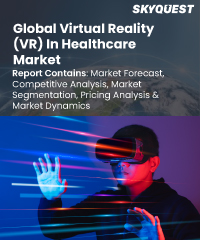
Product ID: SQSG35G2017

Report ID:
SQSG35G2017 |
Region:
Global |
Published Date: February, 2024
Pages:
157
|
Tables:
67 |
Figures:
75
According to geography, North America dominated the global virtual reality (VR) in healthcare market, accounting for more than 46% of total revenue in 2022. High acceptance of these technologies, investment in R&D activities, and supportive government efforts are factors that are fueling growth in this region. The U.S. government's National Institute of Health is providing funding for virtual reality research with a focus on healthcare. For example, as it continues to gather data to back up its virtual reality therapy for pain management, the company AppliedVR has secured a new investment of $36 million to support its expansion.
Additionally, the Los Angeles-based business is anticipating the Food and Drug Administration's (FDA) response to its initial de novo application. Following FDA clearance, the business is now ready to fully commercialize its main medication, EaseVRx. With this money, AppliedVR also plans to expand its product pipeline, carry out more clinical research, develop its VR pharmacy platform, and trial more payers. F-Prime Capital, JAZZ Venture Partners, Sway Ventures, and SVB Ventures all contributed to the round B fundraising. To date, the business has raised $71 million. Furthermore, due to rising demand from payers and healthcare providers to lower treatment costs, there is an increase in North America in the outsourcing of healthcare IT services. The global virtual reality in healthcare market in the region has grown as a result of this reason.
However, due to rising public awareness and better healthcare infrastructure, Asia Pacific is anticipated to see the greatest growth throughout the projection period. Promising locations for outsourcing services connected to the creation and distribution of VR technology in healthcare include developing economies like India, China, Brazil, and Mexico. Due to low knowledge and population uptake, Latin America, the Middle East, and the Asia Pacific are still in the early stages of the development of these technologies. Healthcare spending and service quality are rising in nations like Israel and the United Arab Emirates, which is projected to further fuel market expansion in the area over the coming years.
Our industry expert will work with you to provide you with customized data in a short amount of time.
REQUEST FREE CUSTOMIZATIONVirtual Reality (VR) In Healthcare Market size was valued at USD 2.89 billion in 2019 and is poised to grow from USD 4.03 billion in 2023 to USD 79.85 billion by 2031, growing at a CAGR of 39.36% in the forecast period (2024-2031).
Want to customize this report? This report can be personalized according to your needs. Our analysts and industry experts will work directly with you to understand your requirements and provide you with customized data in a short amount of time. We offer $1000 worth of FREE customization at the time of purchase.

Product ID: SQSG35G2017